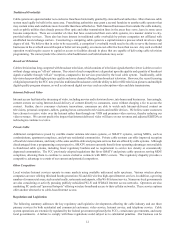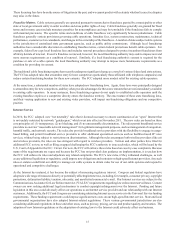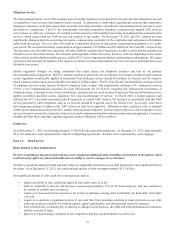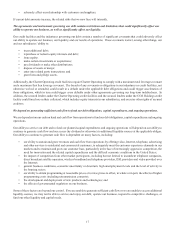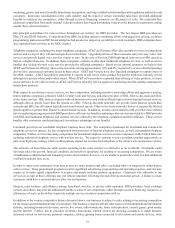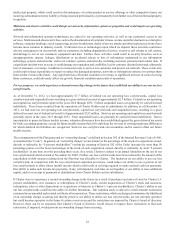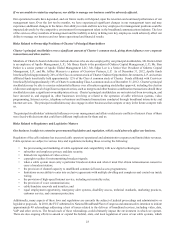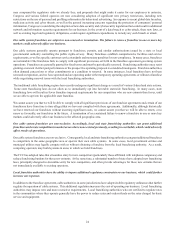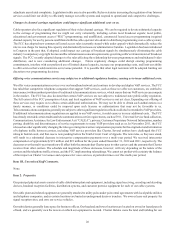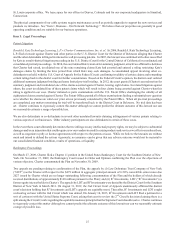Charter 2012 Annual Report Download - page 33
Download and view the complete annual report
Please find page 33 of the 2012 Charter annual report below. You can navigate through the pages in the report by either clicking on the pages listed below, or by using the keyword search tool below to find specific information within the annual report.21
a variety of factors including amounts paid for retransmission consent, annual increases imposed by programmers with additional
selling power as a result of media consolidation, additional programming, including new sports services and non-linear
programming for on-line and OnDemand platforms. The inability to fully pass these programming cost increases on to our
customers has had an adverse impact on our cash flow and operating margins associated with the video product. We have
programming contracts that have expired and others that will expire at or before the end of 2013. There can be no assurance that
these agreements will be renewed on favorable or comparable terms. To the extent that we are unable to reach agreement with
certain programmers on terms that we believe are reasonable we may be forced to remove such programming channels from our
line-up, which could result in a further loss of customers.
Increased demands by owners of some broadcast stations for carriage of other services or payments to those broadcasters for
retransmission consent are likely to further increase our programming costs. Federal law allows commercial television broadcast
stations to make an election between “must-carry” rights and an alternative “retransmission-consent” regime. When a station opts
for the latter, cable operators are not allowed to carry the station’s signal without the station’s permission. In some cases, we carry
stations under short-term arrangements while we attempt to negotiate new long-term retransmission agreements. If negotiations
with these programmers prove unsuccessful, they could require us to cease carrying their signals, possibly for an indefinite period.
Any loss of stations could make our video service less attractive to customers, which could result in less subscription and advertising
revenue. In retransmission-consent negotiations, broadcasters often condition consent with respect to one station on carriage of
one or more other stations or programming services in which they or their affiliates have an interest. Carriage of these other
services, as well as increased fees for retransmission rights, may increase our programming expenses and diminish the amount of
capacity we have available to introduce new services, which could have an adverse effect on our business and financial results.
Our inability to respond to technological developments and meet customer demand for new products and services could limit
our ability to compete effectively.
Our business is characterized by rapid technological change and the introduction of new products and services, some of which
are bandwidth-intensive. We may not be able to fund the capital expenditures necessary to keep pace with technological
developments, or anticipate the demand of our customers for products and services requiring new technology or bandwidth. Our
inability to maintain and expand our upgraded systems and provide advanced services in a timely manner, or to anticipate the
demands of the marketplace, could materially adversely affect our ability to attract and retain customers. Consequently, our growth,
financial condition and results of operations could suffer materially.
We depend on third party service providers, suppliers and licensors; thus, if we are unable to procure the necessary services,
equipment, software or licenses on reasonable terms and on a timely basis, our ability to offer services could be impaired, and
our growth, operations, business, financial results and financial condition could be materially adversely affected.
We depend on third party service providers, suppliers and licensors to supply some of the services, hardware, software and
operational support necessary to provide some of our services. We obtain these materials from a limited number of vendors, some
of which do not have a long operating history or which may not be able to continue to supply the equipment and services we
desire. Some of our hardware, software and operational support vendors, and service providers represent our sole source of supply
or have, either through contract or as a result of intellectual property rights, a position of some exclusivity. If demand exceeds
these vendors’ capacity or if these vendors experience operating or financial difficulties, or are otherwise unable to provide the
equipment or services we need in a timely manner, at our specifications and at reasonable prices, our ability to provide some
services might be materially adversely affected, or the need to procure or develop alternative sources of the affected materials or
services might delay our ability to serve our customers. These events could materially and adversely affect our ability to retain
and attract customers, and have a material negative impact on our operations, business, financial results and financial condition.
A limited number of vendors of key technologies can lead to less product innovation and higher costs. For these reasons, we
generally endeavor to establish alternative vendors for materials we consider critical, but may not be able to establish these
relationships or be able to obtain required materials on favorable terms.
In that regard, we currently purchase set-top boxes from a limited number of vendors, because each of our cable systems use one
or two proprietary conditional access security schemes, which allows us to regulate subscriber access to some services, such as
premium channels. We believe that the proprietary nature of these conditional access schemes makes other manufacturers reluctant
to produce set-top boxes. Future innovation in set-top boxes may be restricted until these issues are resolved. In addition, we
believe that the general lack of compatibility among set-top box operating systems has slowed the industry’s development and
deployment of digital set-top box applications.
We depend on patent, copyright, trademark and trade secret laws and licenses to establish and maintain our intellectual property
rights in technology and the products and services used in our operating activities. Any of our intellectual property rights could
be challenged or invalidated, or such intellectual property rights may not be sufficient to permit us to continue to use certain



